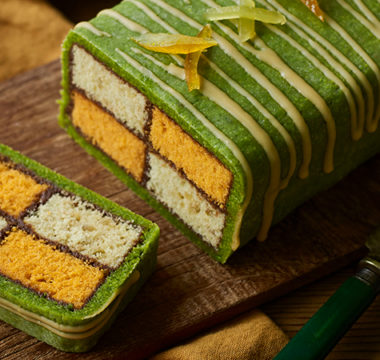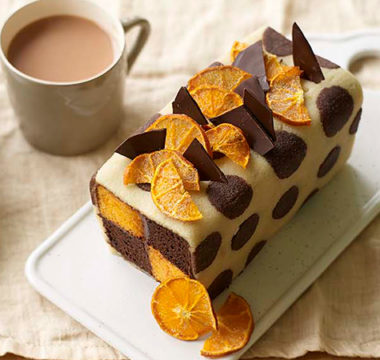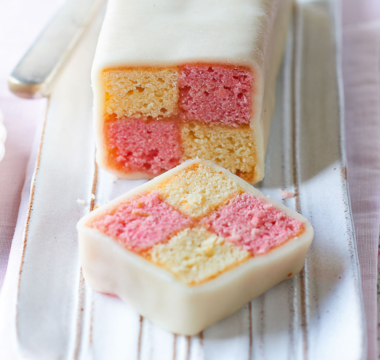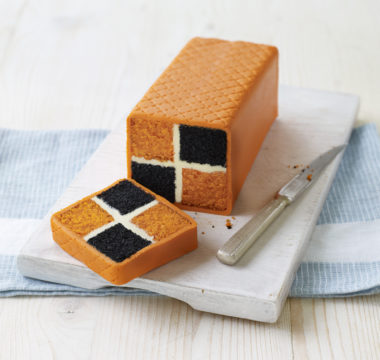Almond and mocha sponges are spread with espresso ‘jam’ that has been laced with vodka and coffee liqueur to give a sophisticated twist to a classic teatime treat.
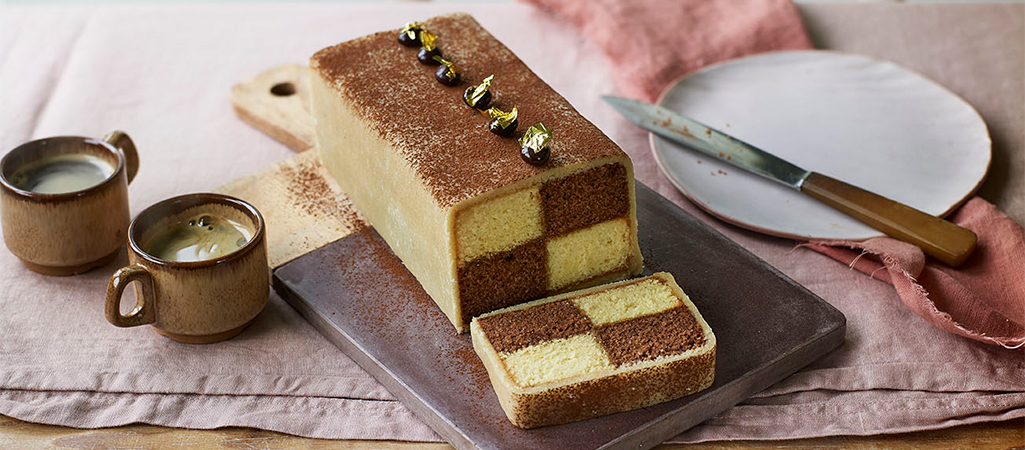

Dave
Series 11
- Ingredients
- Method
Method
Step 1
Heat the oven to 180°C/160°C fan/350°F/Gas 4.
Step 2
Fold the piece of 2-in-1 parchment and foil in half. Holding the folded edge, fold it over by 5cm, then open up the paper on either side and re-crease the centre folds to make a divider. Place this in the centre of the prepared cake tin.
Step 3
Make the sponge. Place the butter and sugar in the bowl of a stand mixer fitted with the beater attachment and mix on slow speed until light and fluffy. Add the eggs, a little at a time, beating well between each addition, until the mixture is smooth.
Step 4
Remove the bowl from the mixer and fold in 140g of the flour, along with all the ground almonds and baking powder. Keep folding until the mixture is smooth and no streaks remain.
Step 5
Place half the mixture into a separate bowl. Add the vodka and the remaining 10g of flour to one bowl, and the sifted cocoa powder and the coffee liqueur to the second bowl. Mix to combine.
Step 6
Transfer each mixture into the divided tin (one in each half), then bake for 30–35 minutes, or until a skewer inserted into the centres comes out clean. Leave to cool for 5 minutes, then run a knife around the edges and turn out the sponges onto a wire rack to cool.
Step 7
Once cool, level the top of each sponge and stack one on top of the other. Trim the sides so that each sponge is a neat rectangle, the same size as the other. Cut through both the centre of both sponges lengthways to give 4 equal, long rectangles. Set aside.
Step 8
Make the espresso jam. Pour the espresso into a small pan and add the sugar. Cook on a medium heat for 10 minutes, stirring occasionally until the sugar has dissolved and the mixture has reduced by one third and becomes syrupy.
Step 9
Meanwhile, place the gelatine leaf in 2 tablespoons of cold water and leave for 5 minutes to soften, then remove and shake off the water.
Step 10
Stir the gelatine into the syrupy espresso along with the vodka and the coffee liqueur, and continue to heat for 2 minutes on a low heat – don’t let the mixture boil. Remove from the heat, then pour into a small bowl and leave to cool completely.
Step 11
Make the marzipan. Place both sugars into a heatproof bowl and add the egg. Mix with an electric hand whisk until smooth, then place the bowl over a pan of simmering water and whisk over a low heat for about 10 minutes, until the mixture is hot and the thickness of lightly whipped cream.
Step 12
Remove the bowl from the heat and place it into a bowl of cold water. Add the vodka and the coffee liqueur, whisk until cool, then stir in the ground almonds to a thick paste.
Step 13
Dust the work surface with icing sugar, tip out the marzipan and knead to a smooth dough. Wrap in cling film and chill for 15 minutes.
Step 14
Assemble the battenberg. Dust the work surface with icing sugar and roll out the marzipan to a 35 x 20cm rectangle and brush a central strip with coffee jam, wide enough to accommodate 2 rectangles of sponge. Take one of the long rectangles of almond sponge and one of the espresso sponges and place them side by side in the centre of the marzipan on top of the jam. Brush jam between the strips of sponge to help them stick.
Step 15
Spread coffee jam on top of the sponges, then place 2 more strips of sponge on top, arranging them to give a chequerboard effect and spreading jam between them to stick them together.
Step 16
Spread the exposed area of marzipan with the coffee jam and fold the marzipan neatly over the sponges to enclose them. Trim and smooth the join if necessary and trim the ends to neaten.
Step 17
To decorate, melt the dark chocolate in a small heatproof bowl over a pan of gently simmering water. Add the coffee beans, then remove each bean and place them spaced apart onto baking paper. Place a little piece of gold leaf on each bean and chill to set for 5 minutes.
Step 18
Dust the top of the battenberg with the cocoa powder, then arrange the gold-topped coffee beans along the centre of the top of the cake.

